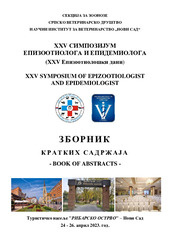Приказ основних података о документу
Nekroza ušne školjke kod svinja – ispitivanje moguće infektivne etiologije
Porcine ear necrosis – investigation of possible infectious etiology
| dc.creator | Kureljušić, Branislav | |
| dc.creator | Savić, Božidar | |
| dc.creator | Milićević, Vesna | |
| dc.creator | Radanović, Oliver | |
| dc.creator | Jezdimirović, Nemanja | |
| dc.creator | Milovanović, Bojan | |
| dc.creator | Weissenbacher-Lang, Christiane | |
| dc.date.accessioned | 2023-07-28T07:54:45Z | |
| dc.date.available | 2023-07-28T07:54:45Z | |
| dc.date.issued | 2023 | |
| dc.identifier.isbn | 978-86-83115-48-8 | |
| dc.identifier.uri | https://reponivs.nivs.rs/handle/123456789/544 | |
| dc.description.abstract | U etiopatogenezi nekroze ušne školjke kod svinja mogu biti uključeni infektivni agensi kao i neinfektivni faktori. Griža ušiju kao oblik kanibalizma obično predstavlja uzrok nekroze ušne školjke kod svinja, ali se nekroza može pojaviti i bez ikakvih dokaza o postojanju griže ušiju. Iako su istraživači ispitivali ulogu različitih uzročnika za razvoj lezija ušne školjke, do sada nije potvrđena definitivna etiologija. U ovom radu opisan je slučaj nekroze ušne školjke 10 uginulih svinja sa jedne komercijalne farme svinja u Srbiji. Prema podacima ordinirajućeg veterinara farme, lezije na ušnoj školjki su prvi put otkrivene kod svinja starosti između 45 i 50 dana kod više od 80% jedinki, u svim boksevima u odgajivalištu. Za ispitivanje su uzete ušne školjke uginulih svinja i sprovedena su patomorfološka, bakteriološka i molekularno-genetička ispitivanja. Makroskopski, ustanovljene lezije su opisane kao blagi, superficijalni dermatitis, a u težim slučajevima, bila je prisutna duboka inflamacija dermisa sa ulceracijom i nekrozom. Histopatološkim pregledom utvrđen je erozivni i ulcerozni dermatitis ušne školjke sa infiltracijom neutrofilnim granulocitima i limfocitima, fibroplazija i bazofilne kolonije bakterija u krastama. U osam uzoraka krasti i tkiva ušiju izolovani su S. aureus (MRSA soj), S. hyicus i Streptococcus grupe C. U dva uzorka otkriven je samo S. hyicus. Svi uzorci bili su pozitivni na T. denticola/T. putidum grupu i negativni na Mycoplasma suis. Sedam od deset oralnih briseva bilo je pozitivno na T. denticola/T. putidum grupu. Dva PCR proizvoda su sekvencionirana i filogenetska analiza je pokazala genetsku sličnost sekvenci nukleotida sa T. medium/T. vincentii grupom i Treponema pedis. Iako su bakterijski agensi uspešno utvrđeni u ispitanim uzorcima ušnih školjki, neinfektivni faktori, uključujući dokazanu visoku vlažnost vazduha i deficit sirovih proteina u obroku, takođe mogu biti uključeni u razvoj sindroma nekroze ušne školjke. Istovremena detekcija treponema u uzorcima krasti i tkiva ušiju i uzorcima brisa usne šupljine može ukazivati na prenos bakterija tokom griže ušiju. Ovaj slučaj još jednom naglašava multifaktorijalni karakter ovog sindroma što otežava kontrolu i prevenciju ove bolesti. | sr |
| dc.description.abstract | Infectious agents as well as non-infectious factors can be involved in the etiopathogenesis of porcine ear necrosis. Furthermore, ear biting is commonly suggested as a cause of ear necrosis in pigs, but it may also appear without any evidence of ear biting. Although many causative agents for the development of ear lesions have been suggested by investigators no definitive aetiology has been identified so far. This report describes case of ear necrosis of 10 dead pigs from one commercial pig farm in Serbia. According to to the data obtained by the farm veterinarian, ear lesions were first detected in pigs between 45 and 50 days of age from all pens and more than 80% of the pig population was affected. Auriculae of dead pigs were sampled and pathomorphological, bacteriological and molecular-genetic examinations were carried out. The lesions ranged from mild, superficial dermatitis to severe, deep inflammation with exudation, ulceration and necrosis. Histopathological examination revealed erosive and ulcerative dermatitis of the pinna with neutrophilic and lymphocytic infiltration, fibroplasia and bacterial colonies in the crusts. In eight ear tissue scraping samples, S. aureus (MRSA strain), S. hyicus and Streptococcus group C were isolated. In two samples only S. hyicus was detected. All ear tissue scraping samples tested positive for the T. denticola/T. putidum group and negative for Mycoplasma suis. Seven out of ten oral swabs were positive for the T. denticola/T. putidum group. Two of the PCR products were sequenced, and the phylogenetic analysis showed a genetic relationship of the treponeme nucleotide sequences to the T. medium/T. vincentii group and Treponema pedis. Although bacterial agents were determined successfully in ear tissue scraping samples, non-infectious triggering factors including proven high humidity levels and crude protein deficiencies may also have been involved in the development of ear necrosis syndrome. The concurrent detection of Treponema in both ear tissue scrapings and oral swab samples might indicate the transmission of the bacterium during ear biting. The present case once again highlights the multifactorial character of this condition that renders the control and prevention of this disease difficult. | sr |
| dc.language.iso | sr | sr |
| dc.language.iso | en | sr |
| dc.publisher | Beograd : Srpsko veterinarsko društvo, Sekcija za zoonoze | sr |
| dc.rights | openAccess | sr |
| dc.source | XXV Simpozijum epizootiologa i epidemiologa (XXV Epizootiološki dani) | sr |
| dc.subject | nekroza ušne školjke | sr |
| dc.subject | svinja | sr |
| dc.subject | Treponema spp | sr |
| dc.subject | Staphylococcus spp | sr |
| dc.subject | Streptococcus spp. | sr |
| dc.subject | porcine ear necrosis | sr |
| dc.subject | pig | sr |
| dc.subject | Treponema spp | sr |
| dc.subject | Staphylococcus spp | sr |
| dc.subject | Streptococcus spp | sr |
| dc.title | Nekroza ušne školjke kod svinja – ispitivanje moguće infektivne etiologije | sr |
| dc.title | Porcine ear necrosis – investigation of possible infectious etiology | sr |
| dc.type | conferenceObject | sr |
| dc.rights.license | ARR | sr |
| dc.citation.epage | 143 | |
| dc.citation.spage | 142 | |
| dc.identifier.fulltext | http://reponivs.nivs.rs/bitstream/id/1264/bitstream_1264.pdf | |
| dc.type.version | publishedVersion | sr |

